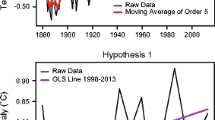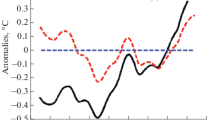Abstract
Statistical models consisting of a trend plus serially correlated noise may be fitted to observed climate data such as global surface temperature, the trend and noise representing systematic change and other variations, respectively. When such a model is fitted, the estimated character of the noise determines the precision of the estimated trend, and hence the precision of the estimate of the magnitude of the systematic change in the variable considered. The results of fitting such models to global temperature imply that there is uncertainty in the amount of temperature change over the past century of up to ± 0.2 °C, but that the change of around one half of a degree Celsius is significantly different from zero.
The statistical models for climate variability also imply that the observed temperature data provide only imprecise information about the climate sensitivity. This is defined here as the equilibrium response of global temperature to a doubling of the atmospheric concentration of carbon dioxide. The temperature changes observed to date are compatible with a wide range of climate sensitivities, from 0.7 °C to 2.2 °C. When data uncertainties are taken into account, the interval widens even further.
Similar content being viewed by others
References
Bloomfield, P.: 1976, Fourier Analysis of Time Series: An Introduction, Wiley, New York.
Bottomley, M., Folland, C. K., Hsiung, J., Newell, R. E., and Parker, D. E.: 1990, Global Ocean Surface Temperature Atlas, Bracknell, U.K. Meteorological Office.
Folland, C. K., Karl, T. R., and Vinnikov, K. Ya.: 1990, ‘Observed Climatic Variations and Change’, in Houghton, J. T., Jenkins, G. J., and Ephraums, J. J. (eds.), Climate Change: The IPCC Scientific Assessment, Cambridge University Press, Cambridge, pp. 195–238.
Hansen, J. E. and Lacis, A. A.: 1990, ‘Sun and Dust versus Greenhouse Gases: an Assessment of Their Relative Roles in Global Climate Change’, Nature 346, 713–719.
Hansen, J., and Lebedeff, S.: 1987, ‘Global Trends of Measured Surface Air Temperature’, J. Geophys. Res. 92, 13345–13372.
Hansen, J. and Lebedeff, S.: 1988, ‘Global Surface Air Temperatures: Update through 1987’, Geophys. Res. Lett. 15, 323–326.
Hosking, J. R. M.: 1981, ‘Fractional Differencing’, Biometrika 68, 165–176.
Jones, P. D.: 1988, ‘Hemispheric Surface Air Temperature Variations: Recent Trends and an Update to 1987’, J. Clim. 1, 654–660.
Jones, P. D., Raper, S. C. B., Bradley, R. S., Diaz, H. F., Kelly, P. M., and Wigley, T. M. L.: 1986a, ‘Northern Hemisphere Surface Air Temperature Variations, 1851–1984’, J. Climate Appl. Meteor. 25, 161–179.
Jones, P. D., Raper, S. C. B., and Wigley, T. M. L.: 1986b, ‘Southern Hemisphere Surface Air Temperature Variations, 1851–1984’, J. Climate Appl. Meteor. 25, 1213–1230.
Jones, P. D., Wigley, T. M. L., and Wright, P. B.: 1986c, ‘Global Temperature Variations between 1861 and 1984’, Nature 322, 430–434.
Jones, P. D., Wigley, T. M. L., and Farmer, G.: 1991, ‘Marine and Land Temperature Data Sets: A Comparison and a Look at Recent Trends’, in Schlesinger, M. E. (ed.), Greenhouse Induced Climatic Change: A Critical Appraisal of Simulations and Observations, (in press).
Kane, R. P., and Teixeira, N. R.: 1990, ‘Power Spectrum Analysis of the Time-Series of Annual Mean Surface Air Temperatures’, Climatic Change 17, 121–130.
Karl, T. R., Helm, R. R., and Quayle, R. G.: 1991, ‘The Greenhouse Effect in Central North America: If Not Now, When?’, Science 251, 1058–1061.
Katz, R. W.: 1982, ‘Statistical Evaluation of Climatic Experiments with General Circulation Models: A Parametric Time Series Modelling Approach’, J. Atmos. Sci. 39, 1446–1455.
Kuo, C., Lindberg, C., and Thomson, D. J.: 1990, ‘Coherence Established between Atmospheric Carbon Dioxide and Global Temperature’, Nature 343, 709–714.
Lindzen, R. S.: 1990, ‘Some Coolness Concerning Global Warming’, Bull. Amer. Meterol. Soc. 71, 288–299.
Mitchell, J. F. B., Manabe, S., Meleshko, V., and Tokioka, T.: 1990, ‘Equilibrium Climate Change - and Its Implications for the Future’, in Houghton, J. T., Jenkins, G. J., and Ephraums, J. J., (eds.), Climate Change: The IPCC Scientific Assessment, Cambridge University Press, Cambridge, pp. 131–172.
Priestley, M. B.: 1981, Spectral Analysis and Time Series, Academic Press, London.
Reed, D. N.: 1986, ‘Simulation of Time Series of Temperature and Precipitation over Eastern England by an Atmospheric General Circulation Model’, J. Climatol. 6, 233–253.
SAS Institute Inc.: 1984, SAS/ETS User's Guide, Version 5 Edition, SAS Institute Inc., Cary, N.C.
Schlesinger, M. E. and Jiang, X.: 1991, ‘Revised Projection of Future Greenhouse Warming’, Nature 350, 219–221.
Wigley, T. M. L.: 1989, ‘Possible Climate Change Due to SO2-Derived Cloud Condensation Nuclei’, Nature 339, 365–367.
Wigley, T. M. L.: 1991, ‘Could Reducing Fossil-Fuel Emissions Cause Global Warming?’, Nature 349, 503–506.
Wigley, T. M. L. and Barnett, T. P.: 1990, ‘Detection of the Greenhouse Effect in the Observations’, in Houghton, J. T., Jenkins, G. J., and Ephraums, J. J. (eds.), Climate Change: the IPCC Scientific Assessment, Cambridge University Press, Cambridge, pp. 239–255.
Wigley, T. M. L. and Jones, P. D.: 1981, ‘Detecting CO2-Induced Climatic Change’, Nature 292, 205–208.
Wigley, T. M. L. and Raper, S. C. B.: 1987, ‘Thermal Expansion of Sea Water Associated with Global Warming’, Nature 330, 127–131.
Wigley, T. M. L. and Raper, S. C. B.: 1990a, ‘Natural Variability of the Climate System and Detection of the Greenhouse Effect’, Nature 344, 324–327.
Wigley, T. M. L. and Raper, S. C. B.: 1990b, ‘Detection of the Enhanced Greenhouse Effect on Climate’, Paper presented at the Second World Climate Conference, Geneva.
Wilson, C. A. and Mitchell, J. F. B.: 1987, ‘Simulated Climate and CO2-Induced Climate Change over Western Europe’, Climatic Change 10, 11–42.
Author information
Authors and Affiliations
Rights and permissions
About this article
Cite this article
Bloomfield, P. Trends in global temperature. Climatic Change 21, 1–16 (1992). https://doi.org/10.1007/BF00143250
Received:
Revised:
Issue Date:
DOI: https://doi.org/10.1007/BF00143250




